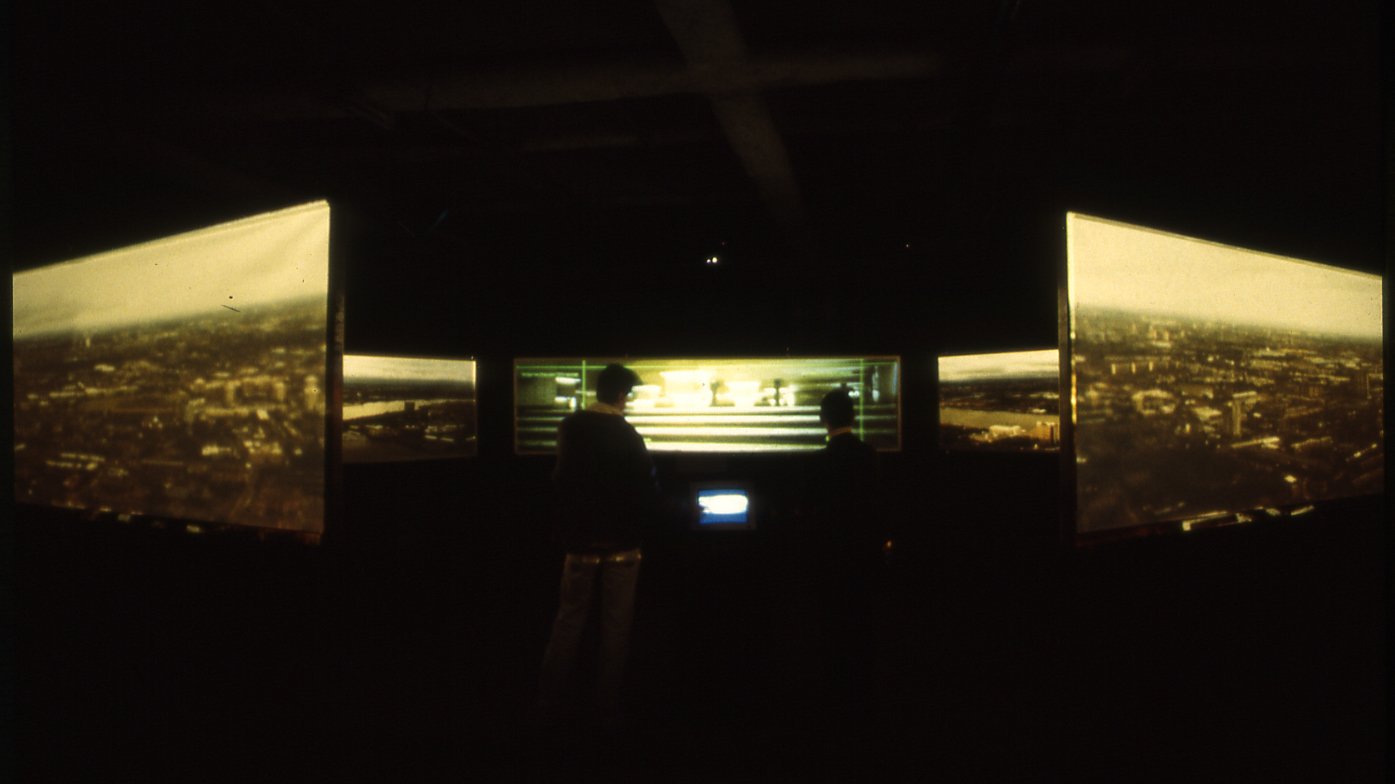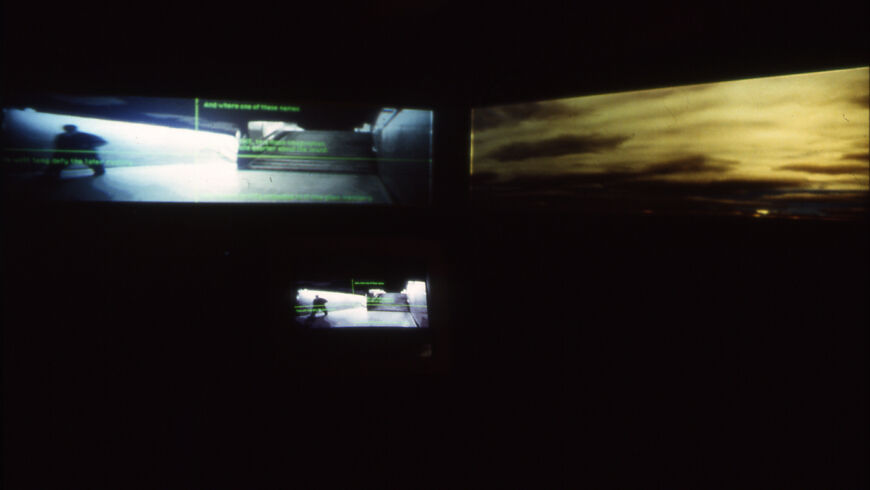'Passagen' by Graham Ellard & Stephen Johnstone is available now on FVU Watch.
Passagen is not a Walter Benjamin hypertext, nor is it Benjamin's 'Passagen-Werk' on CD-ROM. We make this point because it has been suggested that a hypertext version of the ‘Passagen-Werk' notes would be a particularly apt undertaking, aligning the fragmentary, multi-disciplinary and montagist nature of Benjamin's project to the non-sequential multi-linear, intertextual possibilities of the new digital technologies. While aware of these parallels, our main preoccupation in Passagen is to explore a number of specific connections between Benjamin's work and the way the new digital technologies are being currently imagined, in particular with regard to an increasingly common analogy which identifies the new virtual spaces of cyberspace with older topologies of the city.
For example, the metaphor of panoramas and labyrinths which Benjamin adopted in his writing about the city is one that frequently recurs as a feature of the new electronic architecture of cyberspace. In William Gibson's almost universally cited passages in Neuromancer, he describes cyberspace as 'like an endless neon cityscape' and as 'data receding like lights in a city.' Another similarly common image is that of cyberspace as an impossibly complex city of data, a Borgesian labyrinth of unimaginable density. This last analogy is drawn out by Mike Featherstone: 'The world of cyberspace is itself an urban environment – a simulation of the city's information order, in which the city redoubles itself through the complex architecture of its information and media networks a digitized parallel world which from above might appear as a rationally planned city (Le Corbusier's metropolis) but from below reveals itself as a Benjaminesque labyrinthine city, in which no one can get the bird's eye view of the plan, but everyone has to effectively operate at street level ...'.1
In fact, as the 'Passagen-Werk' makes clear, Benjamin's investigative perambulations are not confined to the horizontal level of the street but also take him up and down the vertical axis of the modern city, from the meandering tunnels of the Paris métro to the tourist platform of the Eiffel Tower. Benjamin's desire to take in the heights and depths of the city also involves reaching back to ancient mythologies and age-old imaginings: his descriptions of the underground network of the Paris métro, for example, frequently evoke an ancient mythological netherworld, as well as an unconscious urge to lose oneself or 'tarry' in the compact darkness of the maze and surrender to the pleasures of a childlike reverie in wandering.
His image of the view from the Eiffel Tower, on the other hand, plays upon the more recent, but no less powerful, desire to see the city represented in its entirety in an instant; using the figure of a solar eye – up, as it were, with the angels – taking in the whole of the city with a single magisterial sweep.
Like the photographer Nadar, who, having famously photographed Paris from the basket of a hot-air balloon, descended with his camera into the catacombs, and the fictional Zazi (who given the option of visiting Paris's many attractions wishes only to go to the top of the Eiffel Tower and travel on the métro), Benjamin intuitively understood the high view and the labyrinth to be necessarily linked. For Benjamin, the relationship took the form of the dialectical necessity of holding the city in view by balancing the desire to see everything clearly as if laid out like a map with the need to take on a kind of metaphorical blindness and be guided by nothing but the buried and only unconsciously registered whisperings of place names and long-forgotten events.
Running counter to much recent theorising, which equates the desire for a vantage point with the misguided (or worse) desire for a kind of mastery, Benjamin offers a rich and allusive image of the panorama as a mnemonic trigger:
So today the historian has only to erect a narrow but sturdy scaffolding – a philosophic one – in order to draw the most contemporary aspect of the past into his net. But just as the glorious views of the city the new iron structures afforded ... were initially the exclusive privilege of workers and engineers, so here the philosopher who wants to gain the first vistas must be an independent but sure-footed and – if necessary – solitary worker.2
A brief look at René Clair's celebrated but now little-seen film Paris Qui Dort allows us to penetrate further into Benjamin's allegory of the Tower as vantage point, or even as a complex optical instrument or 'camera'. Paris Qui Dort tells the story of a mad inventor who puts all of Paris to sleep. Except, that is, for its hero who, as the 'top man in Paris', the guardian of the Eiffel Tower, is beyond the reach of the sleep-inducing ray. Given Benjamin's renowned desire to wake the public from a kind of torpor, from a self-induced dream state, the image of the top man in Paris' descending clear sighted and fully awake from high altitude to the still-sleepy streets has tremendous resonance.3
But another question arises in respect of the allegory of the view from the tower. Why the desire to 'draw the most contemporary aspect of the past into (the historian's) net'? The answer resides in Benjamin's belief that a revolutionary potential or energy lies buried in the past, in the all-too-recent refuse of everyday life, in the discarded, the out-of-date and the no-longer-entertaining. Looking again at these obsolescent or superseded forms is not a kind of nostalgic longing, but rather involves a practice of critical remembering, recalling the complex dynamic of dreams and wishes that informed the discarded object's moment of construction and consumption. In Benjamin's words, his researches 'attempted to seize the image of history in the most insignificant fixations of existence, in its refuse as it were.'
In this way, one can see how 19th-century oramic displays, panoramas and dioramas, along with other apparently inconsequential forms of early mass entertainment, might reveal what was common to all of the collective architecture of the later 19th century - underground systems, arcades, factories, casinos, railroad stations and department stores. At a deep level they provided housing for what Benjamin called 'the dreaming collective'. Moreover, to disinter and resurrect such outmoded sites of early bourgeois communion and pleasure was to draw attention to and indeed to demonstrate the revelatory and redemptive power of the historical image.
What Benjamin appears to ask of us in the 'Passagen-Werk' is that we try to reach back to the relentlessly repeated but paradoxically almost unfathomable moment when (now) obsolete technologies were new and wondrous in order to comprehend the lure, the logic, and indeed the strangeness of technological newness itself; a mode of historical analysis important not least in that the Benjaminian idea of historical repetition draws the sting of the rhetorical promise that inevitably accompanies the introduction of new technologies; a feeling of simultaneous excitement and déjà-vu that Benjamin referred to as 'the same promise, the same disappointment.'
This dialectic between promise and disappointment and Benjamin's injunction to 'investigate the new in the context of what has already been there' prompted us to look again at a continuity between obsolete forms of immersive visual technology such as the panorama and the most recent of image-worlds to seduce the 20th-century imagination: virtual reality. We are not alone in pursuing this idea. Moving in a similar direction, Erkki Huhtamo's concept of 'media archaeology' is equally indebted to Benjamin in its analysis of the repeated dreams and desires that underlie the development of media culture.4 Focussing on recurrent figures such as the armchair traveller' or the 'virtual voyager', Huhtamo demonstrates how the commonplace motif of travel without departure can be traced back to optical innovations such the stereoscope or the kaleidoscope. The point of tracing enduring cultural dreams such as armchair travel, Huhtamo claims, is that ‘within the present technocultural context [they] provide a platform for confronting highly different views about the ongoing virtualisation of culture' in order to find 'counter images that rub ... hard against the grain of the semantics of progress.'
As if to confirm that the link between the technologies of the present and the image worlds of the past is not just a matter academic speculation, a publicity article in the London Evening Standard describes a potential Millenium project called the Globorama, 'a super-technology observation tower':
One level of the module will be a straightforward panoramic viewing platform overlooking London, with the added ingredient of being able to conjure up images of the same view at different stages in history.
On other levels, six metre-high 360-degree screens will relay panoramas as they are at that very moment, from video cameras on the Eiffel Tower in Paris, say, or CentrePoint in Sydney. At a touch of a button on one of a bank of consoles, you could receive images, via satellite, from similar towers overlooking Niagara Falls, the Amazon jungle or the streets of Los Angeles. You could talk to people in the Sahara or the Serengeti, watch a typhoon revving up over Hong Kong, or the sun going down over Seattle.
You could even watch the earth from a space shuttle, or journey – in real time – down the human intestine. This is the ultimate in armchair travel, and a new concept in the interactive, multi-media phenomenon of 'infotainment'.
The Globorama is one of three London projects being submitted as an idea for the Millenium. The judges will make a decision in July. If this gets the green light, London will be home to one of the most ambitious, interesting projects ever.
The £90-million 'icon' is intended as a celebration of time and space, an amalgamation of existing technology - never before assembled together in one place - incorporated in a monument whose function will still be relevant and pioneering well into the 21st century.
Drawing on the idea of virtual travel in its already existing, superseded and super-new forms, the Globorama provides an extraordinary confirmation of the link between different historical realisations of the desire to travel without departing.
In fact, it is precisely the almost hysterical all-inclusiveness of the Globorama (nothing less than a kind of panorama of panoramas) that begins to suggest how the rhetorical claims made for late-20th-century forms of immersive and interactive technology must be refracted through the cultural and fantasmatic life of the panoramic image, an optical entertainment that similarly aimed to immerse, embrace and transport its spectator or participant out of one world and into another. But the representational form employed – a form of virtual transport – is now completely obsolete and unconvincing.
1 Mike Featherstone and Roger Burrows, 'Cultures of Technological Embodiment: An Introduction' in Body and Society (Special Issue: Cyberspace/ Cyberbodies/Cyberpunk: Cultures of Technological Embodiment) vol 1, no 3-4, November 1995, pp 10-11.
2 Walter Benjamin, 'N' [re the Theory of Knowledge/Theory of Progress] in Gary Smith (ed.), Benjamin. Philosophy, Aesthetics, History, University of Chicago Press, 1989, p 45.
3 On Paris Qui Dort see Annette Michelson, 'Dr Crase and Mr Clair', October 11, 1979, PP 31-53.
4 Erkki Huhtamo 'Armchair Columbus on the Ford of Jordan: The Home, the Stereoscope and the Virtual Voyager' in film+arc. graz, 2nd biennale of film und architektur (exhibition catalogue), Charlotte Pöchhaker (ed), Graz, Austria.
—
Graham Ellard and Stephen Johnstone have collaborated as artists since their 1993 work Passagen. Graham Ellard is a Professor of Fine Art at Central Saint Martins College of Art and Design, Stephen Johnstone is a Professor of Fine Art at Goldsmiths University of London.


